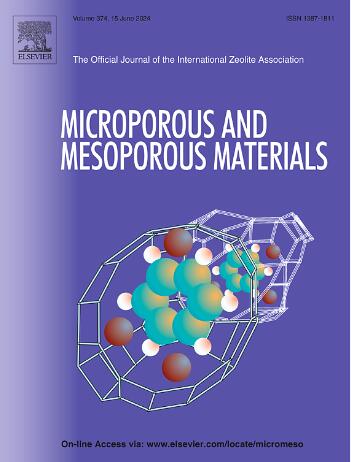Adsorption of Hg(II) from aqueous solutions on β-zeolite: Theoretical-experimental proposal for the surface interaction mechanism and the formation of metal complexes
IF 4.8
3区 材料科学
Q1 CHEMISTRY, APPLIED
引用次数: 0
Abstract
A β-zeolite (Zβ) was synthesized and characterized using X-ray diffraction (XRD), scanning electron microscopy (SEM), atomic absorption spectroscopy, nitrogen adsorption-desorption isotherms, thermogravimetric analysis (TG-DTA), and attenuated total reflectance Fourier transform infrared spectroscopy (ATR-FTIR). The material exhibited a Si/Al ratio of 23.3, a BET surface area of 619 m2/g, and a predominantly microporous structure. The adsorption of Hg(II) onto Zβ was rapid, reaching equilibrium within 40 min. Kinetic analysis best fitted the pseudo-second order model, indicating chemisorption on active sites, while the Freundlich isotherm suggested multilayer adsorption on heterogeneous surfaces. ATR-FTIR analysis suggests the involvement of silanol groups in the adsorption mechanism. After Hg(II) adsorption, the intensity of the hydroxyl (-OH) band at 3370 cm−1 decreased significantly, indicating interaction with the metal ions. Theoretical calculations further elucidated the adsorption mechanism, showing the formation of inner and outer sphere complexes. The inner sphere complex involved direct coordination between Hg(II) and silanol groups, while the outer sphere complex was stabilized by hydrogen bonding. The calculated reaction energies (−0.6 and −2.1 eV) supported the thermodynamic feasibility of these interactions. Density functional theory (DFT) and Ab initio molecular dynamics (AIMD) simulations revealed a significant bandgap reduction upon mercury adsorption, confirming strong electronic interactions. These findings highlight the efficiency of Zβ for Hg(II) removal, particularly at low concentrations. The combined experimental and theoretical approach provides valuable insights into the adsorption process, contributing to the design of advanced materials for heavy metal remediation.

β-沸石对水溶液中汞(II)的吸附:表面相互作用机制和金属配合物形成的理论-实验建议
采用x射线衍射(XRD)、扫描电镜(SEM)、原子吸收光谱、氮吸附-脱附等温线、热重分析(TG-DTA)和衰减全反射傅立叶变换红外光谱(ATR-FTIR)对β-沸石(Zβ)进行了表征。该材料的Si/Al比为23.3,BET表面积为619 m2/g,主要为微孔结构。Hg(II)在Zβ上的吸附速度很快,在40 min内达到平衡。动力学分析最符合准二级模型,表明在活性位点发生化学吸附,而Freundlich等温线表明在非均质表面发生多层吸附。ATR-FTIR分析表明硅醇基参与了吸附机理。Hg(II)吸附后,在3370 cm−1处羟基(-OH)带强度显著降低,表明与金属离子相互作用。理论计算进一步阐明了吸附机理,显示了内外球配合物的形成。内球配合物是Hg(II)与硅醇基之间的直接配位,而外球配合物是通过氢键稳定的。计算的反应能(- 0.6和- 2.1 eV)支持这些相互作用的热力学可行性。密度泛函理论(DFT)和从头算分子动力学(AIMD)模拟显示,汞吸附后带隙明显减小,证实了强电子相互作用。这些发现强调了Zβ去除Hg(II)的效率,特别是在低浓度下。实验和理论相结合的方法为研究吸附过程提供了有价值的见解,有助于设计先进的重金属修复材料。
本文章由计算机程序翻译,如有差异,请以英文原文为准。
求助全文
约1分钟内获得全文
求助全文
来源期刊

Microporous and Mesoporous Materials
化学-材料科学:综合
CiteScore
10.70
自引率
5.80%
发文量
649
审稿时长
26 days
期刊介绍:
Microporous and Mesoporous Materials covers novel and significant aspects of porous solids classified as either microporous (pore size up to 2 nm) or mesoporous (pore size 2 to 50 nm). The porosity should have a specific impact on the material properties or application. Typical examples are zeolites and zeolite-like materials, pillared materials, clathrasils and clathrates, carbon molecular sieves, ordered mesoporous materials, organic/inorganic porous hybrid materials, or porous metal oxides. Both natural and synthetic porous materials are within the scope of the journal.
Topics which are particularly of interest include:
All aspects of natural microporous and mesoporous solids
The synthesis of crystalline or amorphous porous materials
The physico-chemical characterization of microporous and mesoporous solids, especially spectroscopic and microscopic
The modification of microporous and mesoporous solids, for example by ion exchange or solid-state reactions
All topics related to diffusion of mobile species in the pores of microporous and mesoporous materials
Adsorption (and other separation techniques) using microporous or mesoporous adsorbents
Catalysis by microporous and mesoporous materials
Host/guest interactions
Theoretical chemistry and modelling of host/guest interactions
All topics related to the application of microporous and mesoporous materials in industrial catalysis, separation technology, environmental protection, electrochemistry, membranes, sensors, optical devices, etc.
 求助内容:
求助内容: 应助结果提醒方式:
应助结果提醒方式:


